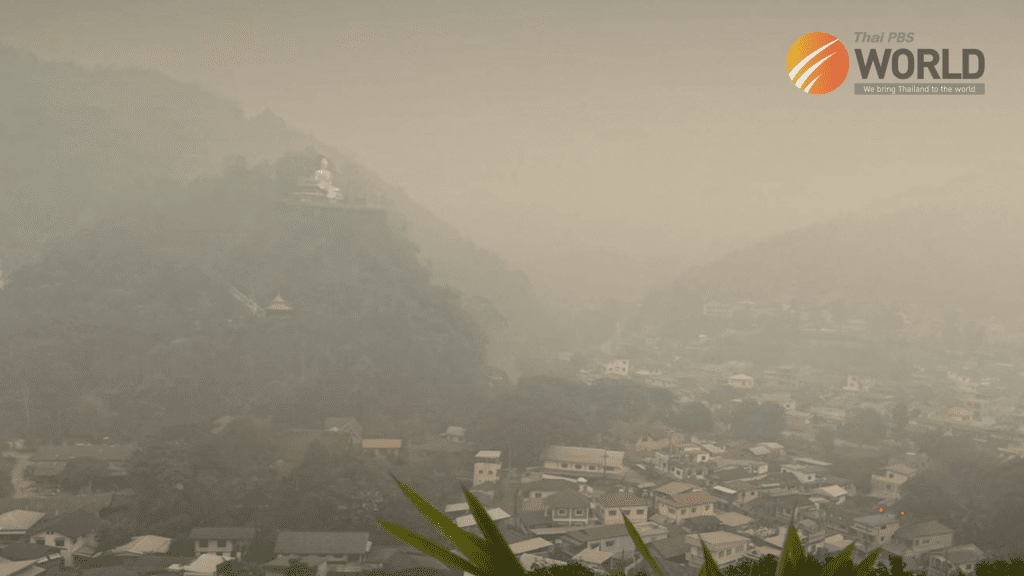National parks have turned to going from house to house in the latest attempt to deal with a long-standing cause of Thailand’s seasonal air pollution crisis – agricultural fires.
“Residents tend to believe that using fire to clear plantations or agricultural waste is normal. Farmers have been doing this for generations. So, it is important that we help them understand the consequences of such actions,” said Naruepol Thipmontha, head of the Forest Protection and Fire Control Office at the Department of National Parks, Wildlife and Plant Conservation (DNP), which is running the campaigns.
Naruepol mentioned the successful campaign done across nearby communities by Wiang Kosai National Park in Phrae.
“Statistics show human-caused forest fires have decreased by 38% this year when compared with 2023,” Naruepol disclosed. He said increasing locals’ understanding of how far a fire lit during the dry season would spread had improved their cooperation.
Human-caused fires are the biggest reason for smog in the country’s rural areas, according to the Thailand Development Research Institute.
Research carried out by Jen Channarong and his team in 2021 revealed 9.7 million rai (1.55 million hectares) in Thailand are burned repeatedly in the seasonal fire-lighting.
Of this, 6.33 million rai are in forest zones while about 3.14 million are in farming zones. The analysis was based on satellite data recorded between 2010 and 2019.
More action is needed
Bunnaroth Buaklee, an advisor to Chiang Mai Delight, a hilltribe education foundation, stated that while efforts to combat smog had improved, it would take much more to resolve the crisis.
“I expected to see new, proactive management styles driving anti-smog efforts. But overall, there have been no big changes,” he commented.
A member of a working panel that monitors three forests in Chiang Mai, Bunnaroth had anticipated that Pol General Phatcharavat Wongsuwan would lead the fight against smog when he was appointed minister of natural resources and environment last year.
“I kind of hoped he would act as the commander-in-chief in this battle. But he has not taken any action,” Bunnaroth complained.
Budget disbursement for operations to prevent or at least rapidly extinguish forest fires has also arrived late, he said.
The Royal Forest Department’s budget of 200 million baht, which will be used to hire locals to watch over local forests, for example, arrived in March.
The timing was poor because by then the seasonal smog problem had already reached its peak. This year, local administrative bodies have taken over the mission of monitoring fires in forest reserves.
But to date they have not yet received a budget to fund those efforts. “Old problems persist,” he said. “We have seen improvements in only a few agencies.”
Asked about the area under his panel’s jurisdiction, Bunnaroth said he had noticed a proactive response to forest fire management.
He therefore expects the area damaged by fire to drop significantly from 800,000 rai last year to just over 500,000 rai this year. The area under his supervision covers Mae Ping, Om Koi, and Mae Teun forest zones in Chiang Mai.
Asst Prof Dr Chakrit Chatamonsak, a teacher at Chiang Mai University’s Faculty of Social Sciences, has created the FireD app for use in Chiang Mai.
FireD handles fire control by reviewing requests for outdoor fire-lighting and approving them where and when appropriate.
For instance, if the weather is suitable, approval may be given. If air quality is already poor, however, requests will be put on hold until further notice.
“In the future, we will include artificial intelligence in our app to ensure the most effective decision-making,” Chakrit said.
FireD was introduced with the belief that outdoor fires are inevitable and should be managed in the most effective way.
Worsening smog
Air pollution in Thailand has deteriorated in recent years, with the danger from PM2.5 fine dust becoming visible even to the naked eye during the worst months of the year.
Many people continue to wear masks not because of COVID-19 but due to poor air quality.
Chiang Mai University lecturer Asst Prof Picha-arpa Pisutserani recently expressed via Facebook that four of her fellow lecturers had succumbed to lung cancer in the past three years.
Their deaths were linked to heavy smog in the North, where Chiang Mai is situated.
The Department of Medical Services has recognized lung cancer as a significant health threat in the northern region.
Every year, 2,487 northerners are diagnosed with the disease. Lung cancer also claims 1,800 lives in the North annually.
The International Agency for Research on Cancer says many air pollutants are cancer-causing agents. Smokers who are exposed to high levels of PM2.5 are at 40% higher risk of dying of cancer than the general population.
Assoc Prof Dr Busayamas Chewaskulyong, who leads the oncology division at Chiang Mai University’s Faculty of Medicine, stated PM2.5 elevates the risk of cancer by up to 1.4 times.
“Exposure to PM2.5 is as bad as smoking,” she said.
Government plan
Prime Minister Srettha Thavisin has already made at least three work trips addressing the smog crisis.
Earlier this year, the government established a committee for sustainable solutions to air pollution. The chair of the committee is Patcharavat.
Provincial commands have also been established to support the committee’s work.
Meanwhile the DNP has vowed to halve the size of areas under its control damaged by fires this year through several measures. For example, it will assign volunteers to set up 3,893 checkpoints to prevent forest fires and monitor forests.
As many as 400 “war rooms” are now up and running across the country to defend forest reserves and conservation areas. Access to forest reserves has also been enhanced.
Teams and facilities have been placed on standby to ensure a rapid response to forest fires. The door-to-door campaigning is another plank in this measure.
“The smog season has already ended this year. Let’s see how we can do more to fight or prevent smog next year,” Bunnaroth said.
By Thai PBS World’s General Desk









